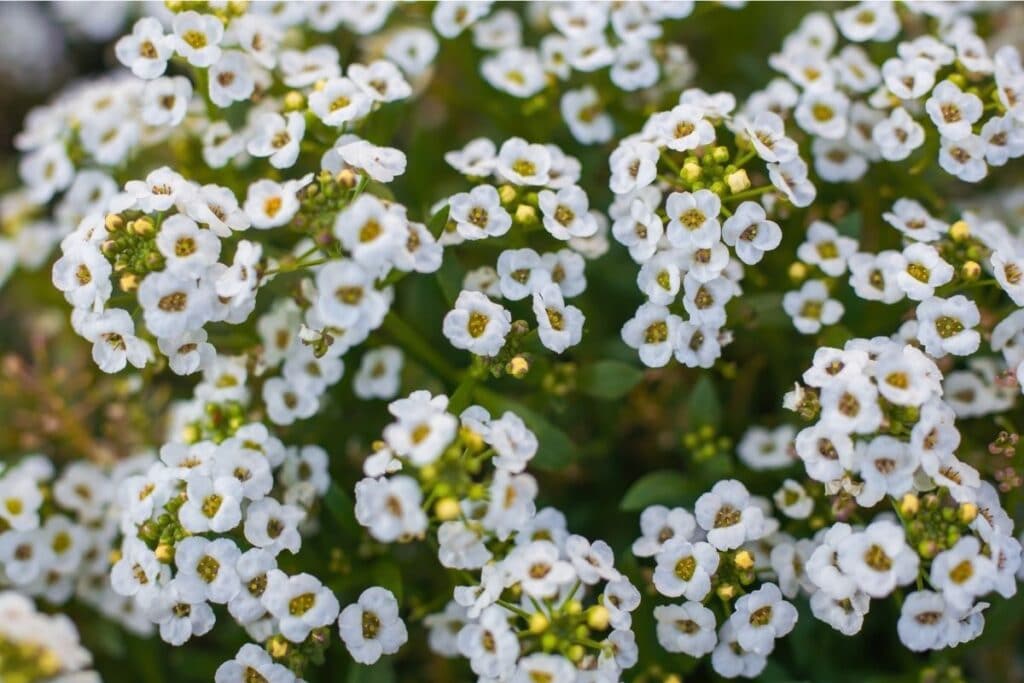The alyssum flower commonly referred to as the sweet alyssum is a popular choice for landscaping across the country. One of its more sought after features is its sweetly-scented flowers that will not only add fragrance to your garden, but will attract butterflies, pollinators, and hummingbirds.
Growing alyssum flowers is a simple and rewarding task for gardeners of any skill level. These plants are easy to start from seeds or cuttings and can also be planted as starts purchased from a greenhouse. However you decide to get your sweet alyssum flowers, they are sure to be a welcomed addition to your landscaping.
What Are Alyssum Flowers?
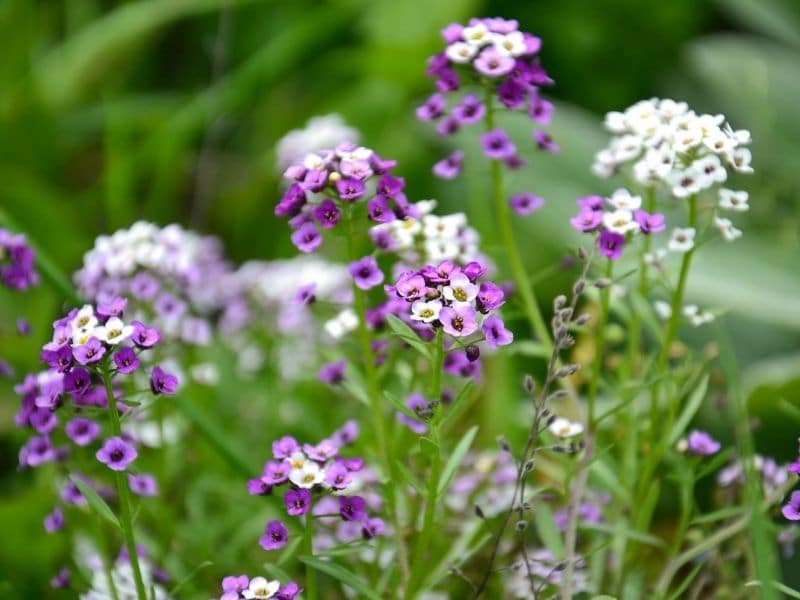
Alyssum flowers are a sweet-smelling bloom that can be found in whites, pinks, purples, yellows, and orange shades. This plant can be found in either mounding or sprawling varieties, giving you some options when it comes to where and how you want to plant it.
Alyssum flowers are considered hardy annuals in USDA hardiness zones one through eight, meaning the plants will live through the growing season and will then die off. If you live in zone nine, ten, or eleven, your alyssum flower plants can be grown as a perennial; they will go dormant in the winter but will come back each growing season for the life of the plant.
Regardless of what climate you live in, alyssum flowers are a relatively easy plant to grow at home. Many plant alyssum because of its disease- and pest-resistant tendencies. Besides basic plant care, your alyssum flowers should not need much special attention. With proper care, your alyssum flowers will be blooming and livening up your landscape in no time.
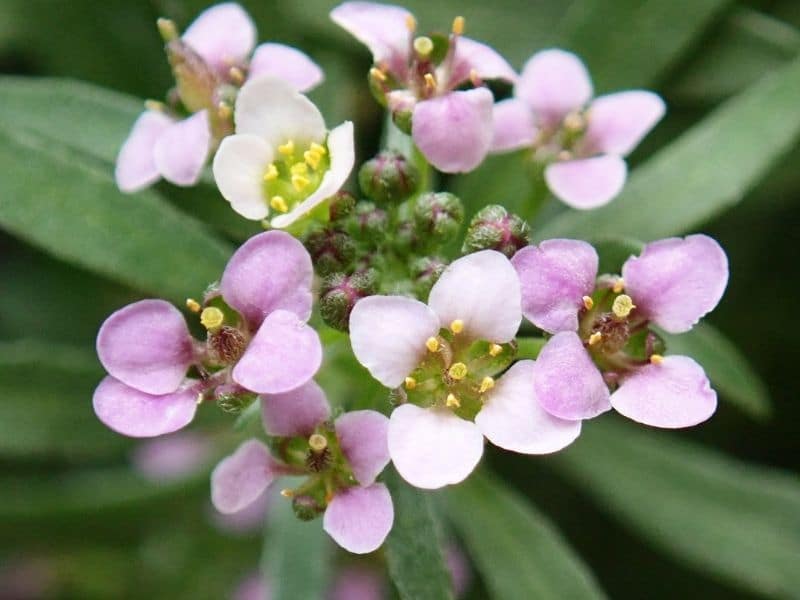
How to Care for Sweet Alyssum
Caring for your sweet alyssum (lobularia maritima) can be a stress-free task when you have the right educational tools. Although a young plant may need some extra attention, once your alyssum flowers are established, their care needs drop to a very manageable level even for the busiest of gardeners.
Following the next few guidelines on alyssum care will have your plants blooming and thriving in no time.
Soil
Soil that is well-drained is ideal for alyssum flowers, as well-drained soil will keep the roots from sitting in water. If the root system is exposed to too much pooling water, the plant may start to wilt and may eventually die. There are also concerns about root rot along with other moisture-related problems.
If planting your sweet alyssum in a planter or hanging basket, a simple potting soil will supply the correct conditions for the plant to thrive. If planting in the ground, it is a good idea to check your soil for its drainage abilities.
If your soil does not drain well, you may want to consider working in other organic materials such as compost, sand, or potting soil. Turning the ground and mixing in a more porous material can create an ideal drainage environment for your alyssum flowers.
Watering
Many of the newer varieties of the alyssum flower are drought-resistant, so watering doesn’t have to be at the top of your chore list. Overwatering is more common than underwatering when it comes to the alyssum flowers, so don’t be too ambitious with the hose or sprinkler system.
Alyssum that is planted in the ground should be watered once a week unless you’ve had sufficient rainfall, in which case watering may not be necessary. If you have your alyssum flowers in a container or hanging basket, water them when the top two inches of soil are dry.
Letting the soil dry out between each watering promotes healthy roots and water intake. Alyssum plants that have just been planted in the ground and are working on establishing should be given extra water. Ensuring your new plant receives water every couple of days will help it acclimate to its new environment and will be more likely to establish and grow at a healthy pace.
Sunlight
Does alyssum like sun or shade? The ideal location for your alyssum is somewhere they can receive full sun exposure during the day. Alyssum flowers are more likely to grow their highest potential number of blooms when planted in full sun.
If you don’t have a full sun location available, the alyssum flowers can tolerate a partially-shaded location as well, although they may not reach their full potential.
If you have your tiny flowers growing in a hanging basket or a container, some shade on particularly hot days may actually help the plant. Although they enjoy full sun, they are more likely to dry out in a container environment than they are in the ground; therefore, some shade may help to make sure this doesn’t happen.
This also holds true for those who live in warmer climates. Giving your alyssum flowers a little bit of shade on any brutally hot days can help keep them happy and healthy.
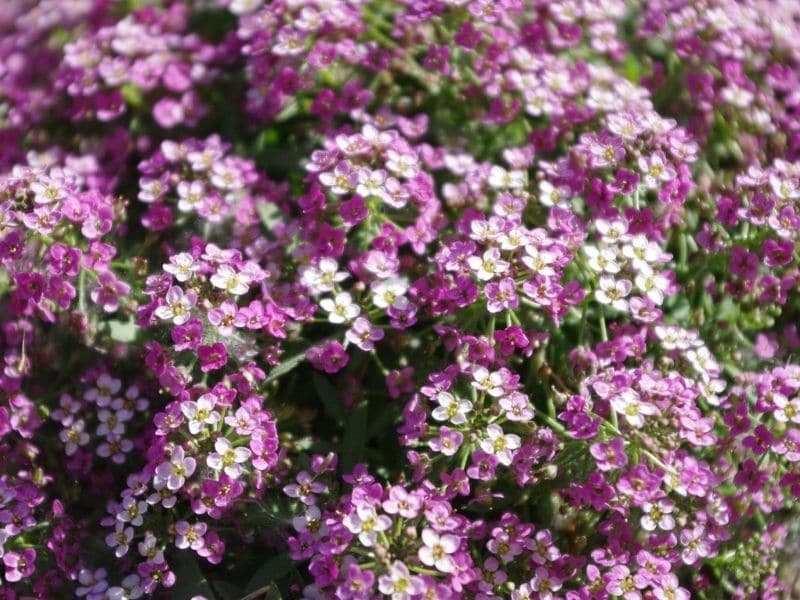
Pruning/ Deadheading
Alyssum flowers do not generally become overgrown, but if you’re working with a small space, trimming back some branches may become necessary. When pruning an alyssum plant, make sure to do small sections at a time. Trimming off too many branches all at once may damage the plant and may result in fewer blooms.
A more common practice with alyssum flowers is the act of deadheading. Deadheading is when you pinch or pick off the dead flowers to encourage new flowers to take their place. There are some newer varieties of alyssum flowers that do not require deadheading to support new growth, but many varieties will still benefit from this.
If you deadhead your alyssum flowers, you can either try to pick the dead flowers off as you see them, or attend to your plants weekly to pinch off any flowers that have died since the previous week. Deadheading is not an exact science, so there’s no need to stress about getting all of the dead flowers off right away.
Fertilizing
Fertilizing your alyssum flowers is optional in most circumstances. Alyssum flowers are generally a very hardy plant, and can self-sustain when their basic needs are met.
Alyssum flowers that are planted directly in the ground rarely need fertilizer, but may benefit from a light, slow-release fertilizer if your soil quality is poor.
Alyssums that are grown in containers are more likely to benefit from fertilizer, as they will probably have less nutrients available in the soil than plants that are growing in the ground.
Fertilizing your container alyssum can be done monthly if necessary and a water-soluble fertilizer should be used. Fertilizing your alyssum flowers can help promote flower growth if your plants are struggling.
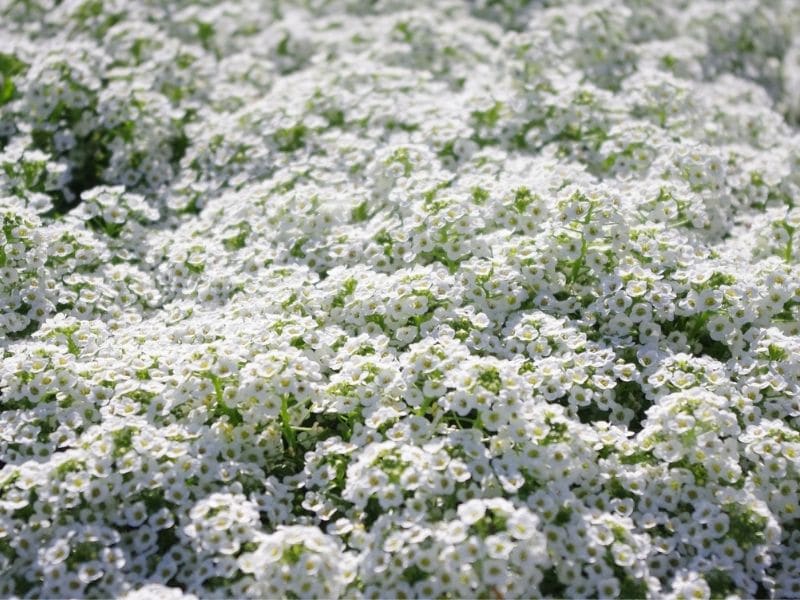
Where to Plant Alyssum Flowers
With so many different varieties of flowers to choose from, there is bound to be a type that works well for your home. There are options when it comes to where you can plant your alyssum flowers, and some of these options are limited by variety choice. Knowing where you want to plant your alyssum before choosing a variety can help you make your final decisions.
Garden/ Landscaping
Planting your alyssum flowers directly in the ground is a popular landscaping choice. Many have flower gardens or sections of flowers that they plant around their home. The alyssum flowers will make a great addition to either with their brightly-colored flowers and sweet scent.
When planting sweet alyssum in a garden or as landscaping, take into account whether your variety is mounding or sprawling. Some plant alyssum as a ground cover to take up sections of a garden; there are many good varieties to choose from for ground cover. Others choose mounding varieties for locations where there is a limited amount of room, or if you just want to leave space for additional flowers.
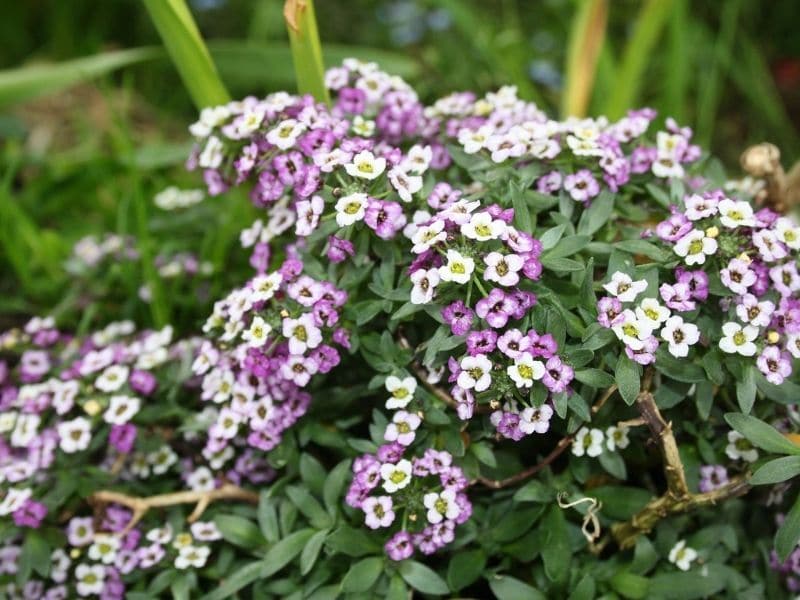
Flower beds
Flower beds are another popular choice for alyssum flower varieties of all different sorts. Although mounding varieties generally work best in a flower bed, sprawling varieties will work, too, granted you have a large enough flower bed.
There are no special instructions for planting alyssum in flower beds other than making sure there is proper drainage for the water, and including decent potting soil. Alyssum flowers are known for their ability to thrive in many different living arrangements.
Containers
Growing your alyssum flowers in containers is another popular choice, particularly among those who have earlier winter months. The alyssum flower can be grown as a perennial in warmer climates, and is generally grown as an annual in cooler climates.
To bypass their cooler climate, some choose to plant their alyssum in movable containers that can be brought inside during winter. This is a good way to get more enjoyment out of each plant if you don’t have the climate to leave them outside all year-round.
When planting in containers, you may need to add fertilizer occasionally, as the plant will pull out nutrients from its limited amount of soil, leaving none for following seasons.
Hanging baskets
Alyssum flowers also do well as a hanging flower basket addition. Many varieties of the alyssum flower stay relatively small, even when fully matured. Their smaller size is ideal for hanging baskets where there is limited room available for growth.
Although mounding varieties can be grown in hanging baskets, the sprawling varieties can create a neat cascading effect that droop down from the basket. Hanging alyssum flowers around your porch can even attract butterflies and hummingbirds.
Common Varieties of Alyssum Plants You Can Grow
When it comes to planting alyssum flowers, there are many different varieties to choose from. Certain varieties will bring you different colors, so if you are wanting an alyssum plant that has purple flowers, for example, you would want to choose a variety that blooms purple flowers.
There are also mounding and sprawling varieties of the alyssum flower, so depending on your landscaping, you may need to choose accordingly.
Royal Carpet
Royal carpet alyssum is a sprawling variety that blooms deep purple flowers. This variety of alyssum only grows to be about two to four inches tall and primarily grows outwards making it a common use for ground cover. Many say that the flowers make a carpet-like effect when used as ground cover hence the name ‘royal carpet’.
This variety of alyssum is also particularly resistant to light frost due to its deep root system, making it a popular choice among those who are prone to early frost.
Easter Bonnet
Easter bonnet alyssum blooms beautiful violet-colored flowers that form in small clusters. The plant itself is a sprawling variety that will only grow to about four inches tall. Most alyssum varieties have flowers that grow slightly spread-out from each other; this variety forms its flower in neatly packed clusters that make it more unique.
The Easter bonnet variety is also known for its strongly scented flowers. Although all alyssum flowers smell good, this variety has one of the strongest smelling flowers.
Carpet of Snow
The carpet of snow alyssum variety is similar to the royal carpet variety in the way that it spreads as a low ground cover that resembles a carpet when fully matured. This variety of alyssum blooms bright white flowers that can blossom as early as four weeks after being sown an impressive turn-around time in the flower world.
This variety thrives in climates that have cooler summer months, but can still be grown in warmer climates. Due to its preference for cooler weather, planting it in partial shade may be a good idea if you live in a warmer climate.
Snow Crystals
Snow crystal alyssum is a mounding variety that blooms white flowers that form in an icicle-like fashion. The flowers themselves are also larger than most other alyssum flowers. Even as a mounding variety, these plants will not grow to be much taller or wider than a foot in either direction, making them great for small gardens or as potted plants.
The snow crystal alyssum variety is prone to high heat, and is another variety that prefers cooler climates. Providing some light shade in warmer climates can help to keep it from enduring any heat damage.
Navy Blue
The name speaks for itself this variety of alyssum has navy blue flowers, which actually range from a navy blue to a dark purple in some cases. This variety is considered one of the hardiest varieties and can withstand harsh weather conditions on either side of the spectrum. If you live in an unpredictable climate, this may be the alyssum variety for your garden.
The scent of the navy blue alyssum flowers is also stronger than many other varieties of the plant. It is known for attracting butterflies, pollinating insects, and hummingbirds making it a popular choice among many.
Rosie O’Day
The Rosie O’Day variety is another popular choice, this time for its vibrant flower colors. This variety of alyssum can be found in white, purples, and pink; each color variety boasts bright shades that will stand out among your other garden flowers. These flowers are also more likely to attract insects and hummingbirds.
The Rosie O’Day alyssum takes a little longer to blossom, about eight to ten weeks, but the reward of the vibrant flowers is worth the wait. This is another variety that does not do well in high heat situations, and may do best in cooler climates.
Alyssum Flower Medicinal Uses
Believe it or not, there is some evidence to support the use of alyssum flowers for some medical ailments. It is important to note that none of these uses are scientifically backed and that a doctor should always be consulted for any medical interventions.
The use of alyssum flowers for certain medical uses has been around for centuries, and has been used around the world.
Some of the more popular medicinal uses include treating coughs, abdominal pain, treating rabies (please see a medical professional right away if you believe you have been exposed to the rabies virus), treating scurvy (please see a medical professional if you think you might have scurvy), removing excess fluids from your system, promoting urine secretion, supporting renal functions, and treating gonorrhea (again please see a medical professional before treating gonorrhea with alyssum flowers).
Although these uses may not be scientifically backed, there is evidence of people using alyssum flowers to treat these conditions throughout history.
When used for medicinal purposes, you are supposed to eat the leaves, flowers, and stems when the plant is still young. Many recommend adding these parts of the plant to a salad. Eating alyssum leaves, flowers, and stems will not harm you unless you are allergic to the plant.
FAQs
What is sweet alyssum good for?
Sweet Alyssum (Lobularia maritima) is commonly used as a ground cover or edging plant in gardens. Its low-growing habit and fragrant flowers make it suitable for borders, containers, and rock gardens.
How long does sweet alyssum flower?
Sweet Alyssum is known for its long flowering period. It can bloom profusely from early spring to fall, providing continuous color and fragrance in the garden.
Can sweet alyssum be potted?
Yes, Sweet Alyssum plants can be grown in pots or containers. Its compact size makes it well-suited for container gardening, hanging baskets, or window boxes. Ensure the container has good drainage and use a well-draining potting mix for optimal growth.
*Image by depositphotos.com/LuGrish

